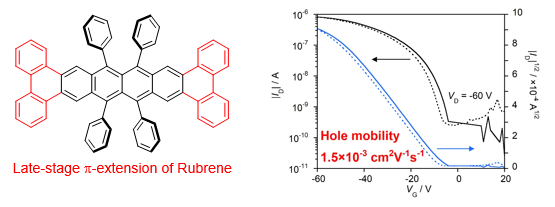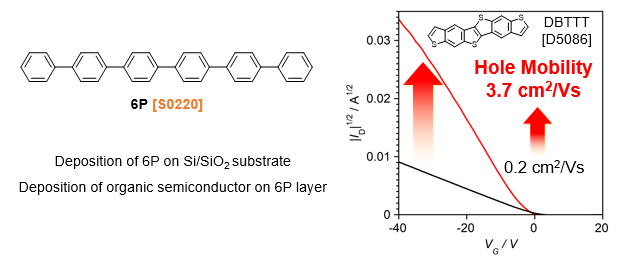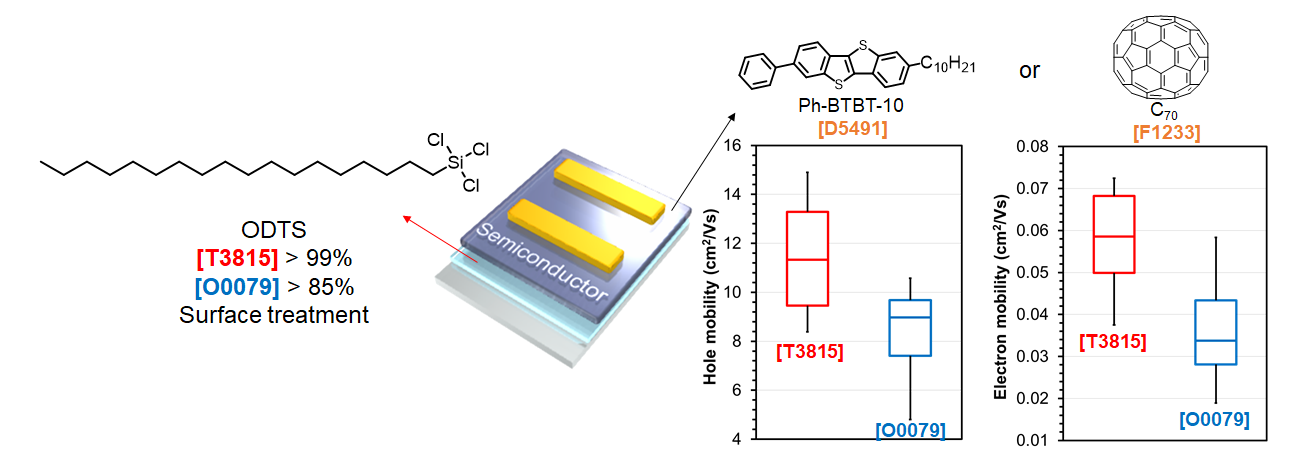Maximum quantity allowed is 999
Featured Articles on Organic Transistor (OFET)
An Example of OFET Evaluation: π-Extended Rubrene via Dearomative Annulative π-Extension (DAPEX) Reaction
TCI demonstrated the fabrication and evaluation of OFET device based on a new rubrene derivative having a π-extended acene core. The device showed a maximum hole mobility of 1.5×10-3 cm2V-1s-1, which is comparable to that for rubrene-based devices.

Morphology Control using “p-Sexiphenyl (6P)” for Performance Improvement of OFET
TCI has commercialized the production of high-purity “p-sexiphenyl (6P)” [S0220] with minimal variation between lots. The insertion of a 6P layer can improve the morphology of overlaying organic semiconductor layers and increase the performance of OFETs. A similar performance improvement has also been demonstrated for two other oligophenylene compounds.

An Example of OFET Evaluation: High-Mobility / High-Solubility p-Type Organic Semiconductor “Ph-BTBT-n” Series
TCI has commercialized the analogs of Ph-BTBT-10 with different alkyl chain length, Ph-BTBT-n (n = 4, 6, 8, 12). While the analogs with shorter alkyl chain possessed higher solubilities, the analogs with longer alkyl chain indicated higher mobilities in OFETs.

Surface Modification using “Trip-C12'” for Performance Improvement of OFET
TCI has commercialized a tripodal triptycene “Trip-C12'”, which self-assembles into completely oriented molecular film. OFET performances were improved by inserting the Trip-C12‘ layer between an active layer and an insulator.

An Example of OFET Evaluation: High-Performance S-Shaped Organic Semiconductor “S-DNTT-10”
TCI has commercialized a high-performance S-shaped organic semiconductor “S-DNTT-10”. We demonstrated fabrication and evaluation of OFET devices using in-house equipment. This product possesses excellent electrical properties and air stability. In addition, it can be handled in both wet and vacuum device fabrication processes.

High-purity silane coupling agent: octadecyltrichlorosilane (>99.0%)
TCI has commercialized a quite high-pure “octadecyltrichlorosilane (ODTS) (> 99%) [T3815]”. We demonstrated a correlation between the purity of ODTS and the performance of OFET devices using an in-house system, and revealed that OFET devices with the high-pure ODTS (>99%) [T3815] exhibited higher carrier mobilities than those with the conventional ODTS (>85%) [O0079]

Purification via sublimation and Comparison of FET performances: Pentacene [P2524]
We demonstrated the fabrication and evaluation of OFET devices by using high-purity "pentacene (99.999%) [P2524]" and other companies’ pentacene samples. P2524-based FET devices showed high performance with hole carrier mobilities of 0.39 cm2/Vs (bare substrate) and 1.52 cm2/Vs (OTS-treated substrate).
![Purification via sublimation and Comparison of FET performances: Pentacene [P2524]](/assets/cms-images/pentacene-fte-comparison.jpg)
An Example of OFET Evaluation: p-type semiconductor material "Ph-BTBT-10"
We demonstrated the fabrication and evaluation of OFET devices by using “Ph-BTBT-10 [D5491]”. The device showed high performance with a hole carrier mobility of 14.0 cm2/Vs.

An Example of OFET Evaluation: Polymer p-type Material “P3HT(regioregular)”
We demonstrated the fabrication and evaluation of OFET devices by using “P3HT (regioregular) [P2513]”. The device showed high performance with a hole transport mobility of 0.1 cm2/Vs.

An Example of OFET Evaluation: P-type material "pentacene"
We demonstrated the fabrication and evaluation of OFET devices by using “pentacene [P2524]” sublimed grade. The device showed high performance with a hole carrier mobility of 1.52 cm2/Vs.

An Example of OFET Evaluation: P-type material "DPh-BTBT"
We demonstrated the fabrication and evaluation OFET devices by using the "DPh-BTBT [D3526]": high-mobility and air-stability p-type material. The device showed high performance with a hole carrier mobility of 3.0 cm2/Vs in the air.

